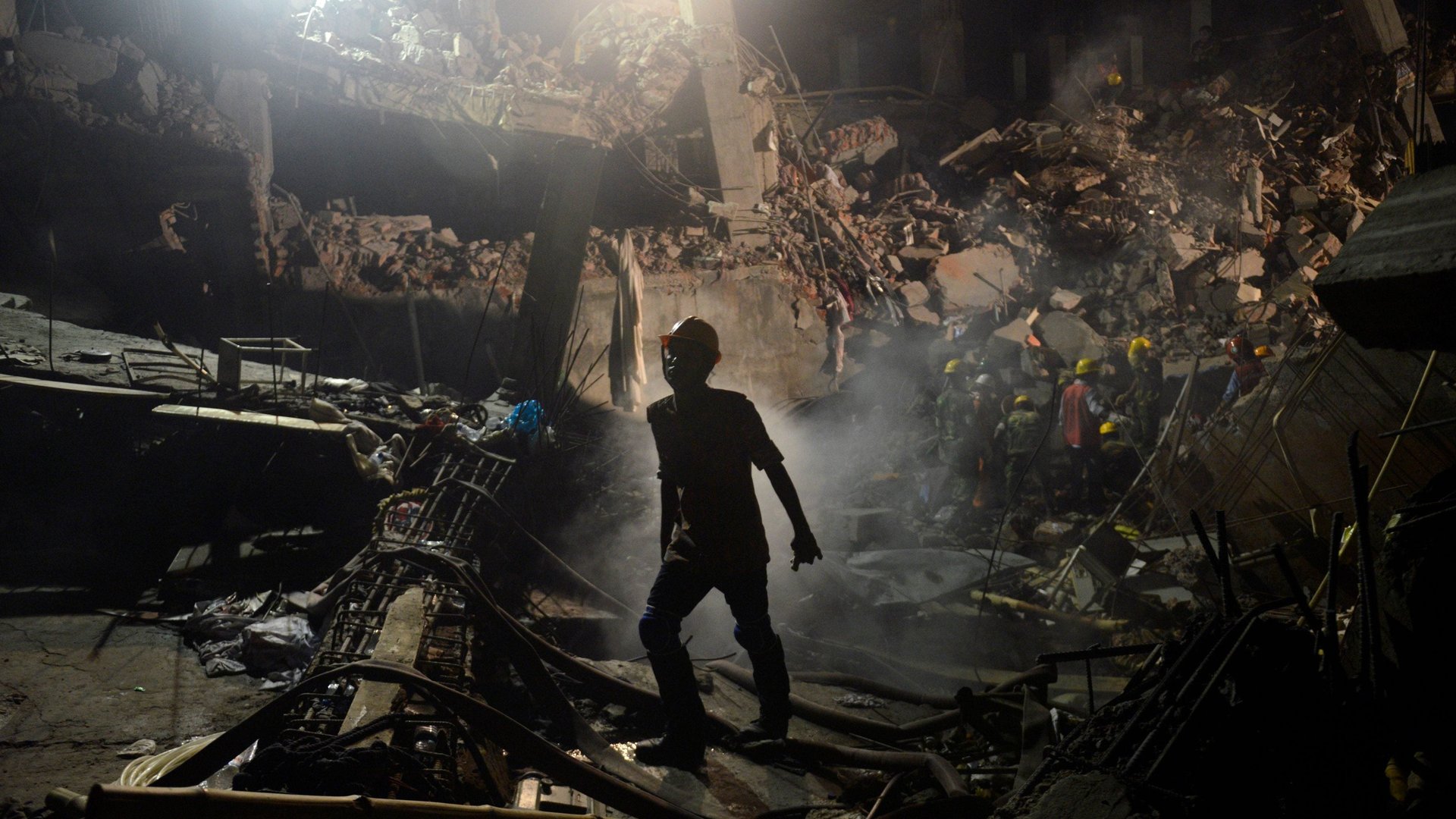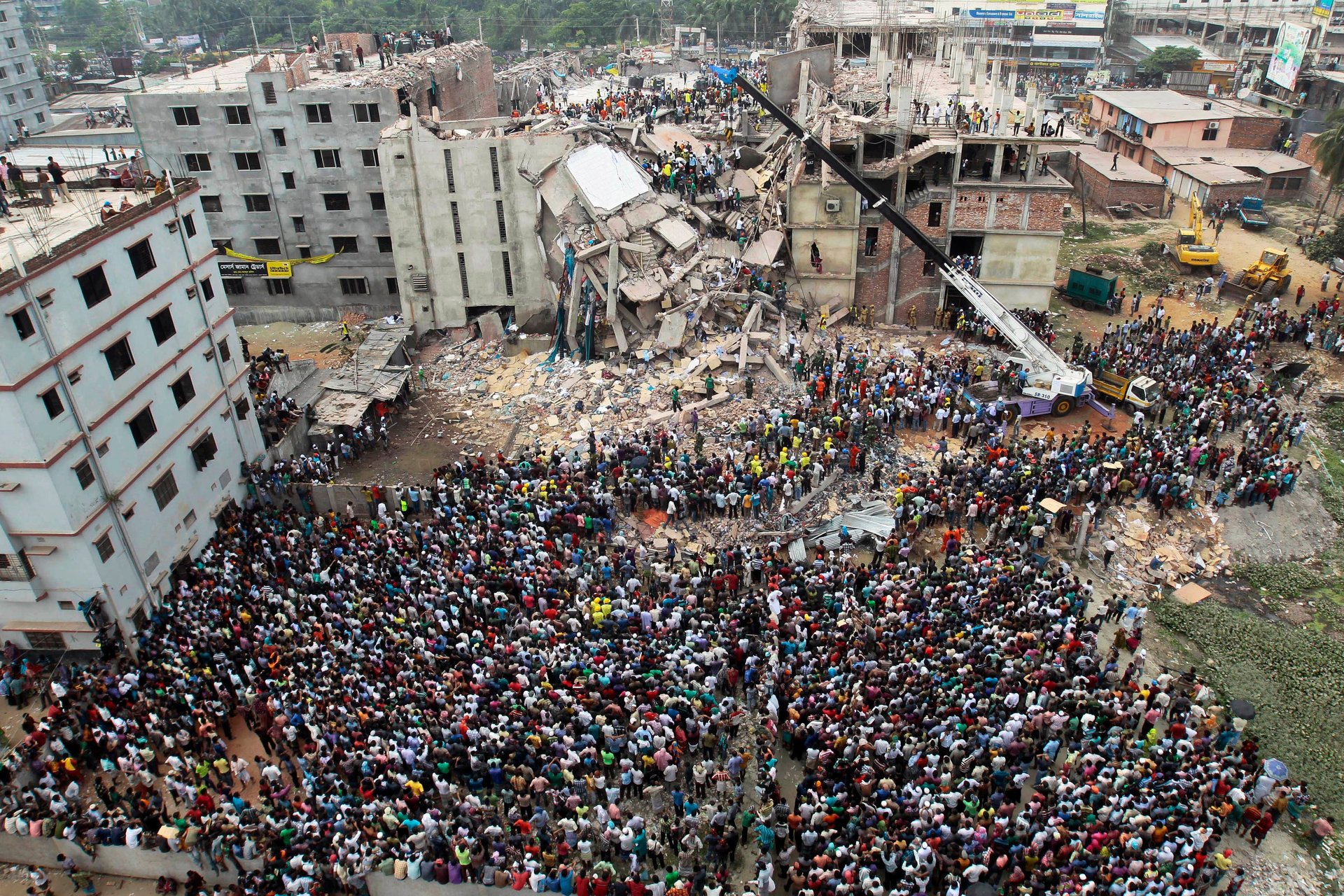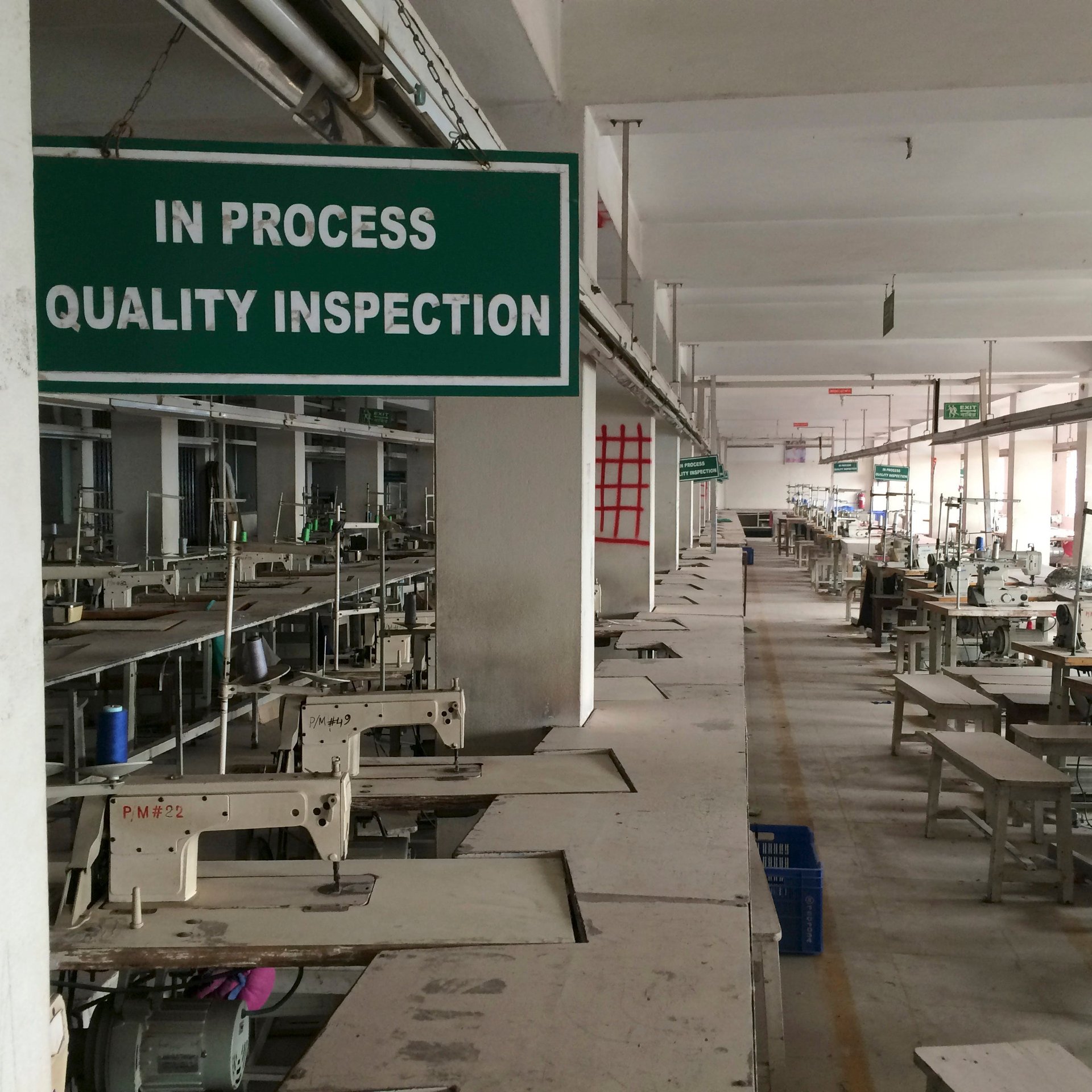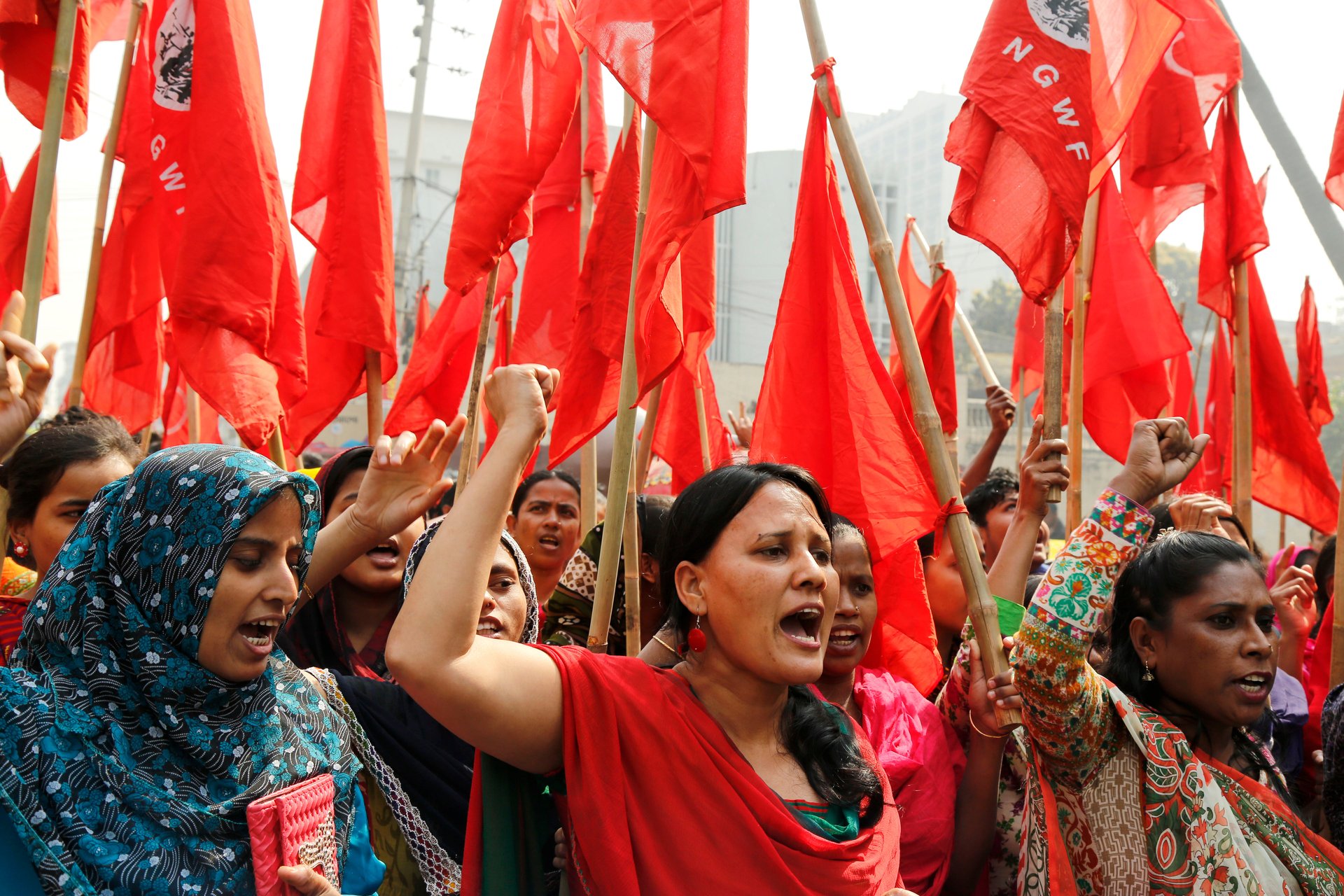Two garment factory disasters a century apart show how globalization has sapped labor’s power
It would take weeks before the full number of dead from the Rana Plaza factory collapse was clear. “Each time we moved a slab of concrete, we found a stack of bodies,” Brigadier-General Siddiqul Alam, the Bangladeshi army officer who oversaw the recovery operation, told the BBC on May 10, 2013.


It would take weeks before the full number of dead from the Rana Plaza factory collapse was clear. “Each time we moved a slab of concrete, we found a stack of bodies,” Brigadier-General Siddiqul Alam, the Bangladeshi army officer who oversaw the recovery operation, told the BBC on May 10, 2013.
On April 24, an eight-story tower, bustling with workers in multiple factories—some making clothes for international brands—had crumbled into rubble. All told, 1,134 were killed, and more than twice that injured.
The worst industrial disaster in Bangladesh’s history, it offered an uncomfortable echo of another tragedy that had happened oceans away and a century earlier. On March 25, 1911, a fire at the Triangle Shirtwaist factory in New York City killed 146 garment workers, many of them young immigrant women and girls. That disaster is often credited with galvanizing America’s nascent organized labor movement, and spurring a process that led to public safety improvements and laws to protect workers.
And yet 102 years later in Bangladesh, garment workers were still facing the same struggles and hazards. Only, in Rana Plaza the numbers involved were far larger. The death toll at Rana Plaza was 10 times that of the New York fire. And Bangladesh’s enormous garment industry is hard to measure, but by some estimates employs almost 5 million—the size of New York City’s entire population in 1911.

After both these horrific, preventable tragedies—as warnings ignored and stairways barred by locked doors leaked out—there was a wave of outrage and action. The main outcome of each was much-needed attention finally being paid to the unconscionable safety hazards in factories.
The Triangle fire led to rounds of inspections and important legislative reforms, at the local and state level, that made factories safer for workers. After Rana Plaza, two campaigns of inspections and remediations sought to reform much of Bangladesh’s garment industry. Five years after the collapse, as these agreements, which center on the economic leverage held by international brands, reach their deadlines, they too have made many factories safer.
But unfortunate differences are also emerging. The Triangle fire led not only to health and safety reforms, but also spurred on the burgeoning US labor movement, presenting a stark window into the chronic labor abuses that garment workers suffered, including poverty wages, excessively long hours, and child labor.
It remains unclear whether long-lasting labor reform will happen in Bangladesh, but unless circumstances in the country change dramatically, it seems unlikely to. After a brief period of workers’ unions growing, they’re again stagnating, and they face tight restrictions by Bangladesh’s government. The country’s workers—the lowest paid among the world’s top 10 apparel exporters—saw an increase in the minimum wage just after Rana Plaza, but that rate hasn’t moved since, and in terms of purchasing power, is steadily shrinking.
Of course Bangladesh’s garment industry exists in a very different world from the Triangle factory. Its workers are at the end of a long, global chain of multinational corporations hopping the globe in search of the lowest prices they can find. Bangladesh’s economy has grown by accommodating these international brands, including H&M, Gap, Inditex, and Walmart. The Bangladeshi people have benefited—at least according to the common narrative that low-skilled work in poor conditions is a normal phase of a country’s economic development as it becomes wealthier.
But for now at least, Bangladesh remains attached to its role as some of the world’s cheapest labor, relying on it for its main competitive advantage. The years since Rana Plaza only serve to emphasize the point, and show just how much power is now concentrated in the hands of multinational corporations.
The corporate effort to reform a national industry
The aftermath of Rana Plaza represents an unprecedented effort by multinational brands, shamed by the disaster and the international outcry that followed, to reform a country’s entire industry—a new role for clothing companies. Historically, governments move to regulate, or private owners are forced to act after pressure from the workers themselves.
In New York in the early 20th century, the flourishing progressive movement was already concerned about the consequences of society becoming rapidly industrialized, and trade unions were gaining political power. About a year and a half before the Triangle fire, 20,000 to 30,000 garment workers went on strike in New York, in what became known as the Uprising of the 20,000. The workers looked to trade unions for help in the face of police intimidation, and earned political leverage by joining the International Ladies Garment Workers’ Union. After the Triangle fire, New York’s city government—and some in the political machine known as Tammany Hall—saw the wisdom of joining forces with these reformers.
In Bangladesh, unions have been demanding change, but corporations have been the ones with the clout to push for reforms. After Rana Plaza, two coalitions of international clothing brands and various other stakeholders formed with the goal of making Bangladesh’s garment industry safe. The Accord and the Alliance, as the two coalitions are known, have significant differences in structure. The big distinction between them, which has led to some sniping back and forth, is the largely European Accord also included global trade unions and could impose sanctions on brands if they didn’t meet their obligations. The Alliance’s mostly American signatory brands don’t face the same penalties. Instead, brands that don’t comply are kicked out of the organization, but still have to cover unpaid annual dues and a one-year termination fee. As of now, a spokesman for the Alliance said, they have not had to take this step against any brand.
But both have functioned by leveraging their brands’ economic power within Bangladesh to get factory owners to upgrade their facilities. Factories that didn’t comply face being cut out by all the brands in the agreement. “Nothing quite like this had been tried before, certainly not at this scale,” notes a recent report by the NYU Stern Center for Business and Human Rights on the progress made since Rana Plaza.
The structure of these agreements is a tacit acknowledgement that the brands—not the factory owners, and not the local unions—are the ones in power, and that the government couldn’t be relied upon to do the job.
The good news is that the industry is actually safer. Dorothée Baumann-Pauly, research director for the NYU Stern Center for Business and Human Rights, has spent time on the ground in Bangladesh researching the garment industry, and says despite their differences, from what she’s seen both groups have succeeded in improving safety at the factories under their watch.

The Accord reports that 84% of the safety problems it identified in its initial factory inspections have now been fixed. The Alliance says 89% of the issues that were not in compliance with its standards have now been addressed. These improvements include installing proper fire doors, updating electrical wiring, and making structural upgrades. There has also been only one major fatal incident in a Bangladesh garment factory since Rana Plaza. It occurred when a boiler exploded, killing 13 people at an Accord factory last year.
Hazards do persist—a fact the Accord candidly admitted in a January progress report (pdf), stating that ”life-threatening safety concerns remain outstanding in too many factories.” Baumann-Pauly points out that factories made the easy, inexpensive fixes first, meaning some of the work left involves complex upgrades that require big investments, such as installing sprinkler systems. Funding such fixes has been an ongoing issue, and will continue to be.
The center’s report also detailed what is maybe the biggest safety gap that remains: the thousands of factories not covered by either agreement. There are some 1,650 other garment factories producing for the domestic market or for export to countries such as Turkey and Russia that are under the oversight of the Bangladeshi government, which has been far less effective at ensuring factories make the fixes needed. Beyond these, a vast unregistered industry of subcontracting factories exists outside the scope of any safety regulations, waiting for the inevitable overflow orders that the directly contracted factories can’t handle. Estimates of its size vary, but it could include as many as 4,000 facilities.
The brands have spearheaded the effort in part because they undoubtedly recognize it’s the right thing to do. But one of the consequences of Rana Plaza was that it put clothing companies’ reputations and brand images in jeopardy—turning off customers who increasingly identify as “conscious” and seek a positive story about the clothes and products they buy. Images of bodies being pulled from the rubble cast a harsh spotlight on a trade regime these companies had long benefitted from, and even helped to create.
How Bangladesh built its massive garment trade
Bangladesh’s garment industry first emerged in the 1970s, some time after the Bangladeshi military took over in a coup, halting the country’s move toward socialism and shifting it toward development through foreign investment and private business. The country benefited from a global export-quota system called the Multi-Fibre Arrangement, which exempted it from limits on sales of clothes to the US and Europe. When Korean and Taiwanese companies started hitting their limits on exports to the West, they opened factories in Bangladesh.
Bangladesh continued to attract foreign business to its garment industry by promoting its low costs. As Baumann-Pauly and her co-authors explained in their report:
The government signaled to foreign fashion brands that the country’s poor rural population provided a large labor pool eager for $1-a-day jobs. “They used words like ‘value,’ ‘good bargain,’ and ‘reliable workforce,’ and the brands understood what they meant—low wages and low prices for the clothes,” says Sanchita Saxena, director of the Chowdhury Center for Bangladesh Studies at the University of California, Berkeley.
Steadily the companies poured in. Today, Bangladesh is the second-largest garment exporter in the world, after China. In 2016, it exported more than $28 billion worth of clothes. H&M, Inditex, Gap, Walmart, C&A, and numerous other international labels have flocked to the South Asian nation, all seeking low-cost production. Clothes have steadily grown to account for more than 80% of its total exports.
Rock-bottom wages for workers are a key component of Bangladesh’s low prices. In December 2016, tens of thousands of Bangladeshi garment workers went on strike, demanding higher pay. The minimum wage, set in 2013, is 5,290 taka per month (about $64), though too often garment factories have failed to pay even that. Workers want to see wages roughly triple, to 16,000 taka (about $192).
Many workers do earn more than the minimum. A Fair Labor Association (FLA) study of data from thousands of workers, collected over three years, found their average wages were 7,797 taka per month.
The amount, though, is just barely above the World Bank poverty line, and far short of a “living wage” that would allow workers to meet their needs, support their families, and still have a small amount left over to save. And many only reach that level of pay by working gruelingly long hours.
“To supplement their income, all workers in this study were depending on overtime, which accounts for more than 20 percent of the average worker’s wages,” the FLA report states. “Half of all workers studied were regularly working more than 60 hours a week, despite the negative effects on worker health and wellbeing of such long hours.”
In theory, wages should be rising as Bangladesh gets better at churning out clothes, but that doesn’t seem to be happening. Between 1994 and 2015, Bangladesh’s labor productivity increased 391%, yet wages rose only 22%, according to a large-scale study on Bangladesh by Lilac Nachum, a professor of international business at City University New York.
Indications are that the sourcing practices of international brands are playing a role in keeping wages down. Mark Anner, director of Penn State University’s Center for Global Workers’ Rights, reported in a study released in March (pdf) that brands are generally paying less for garments today than they did before Rana Plaza.
The price of men’s and boy’s cotton trousers exported to the US (Bangladesh’s top garment export to the country) fell about 13% between 2013 and 2017. Similarly, the price paid for t-shirts exported to the EU (again, Bangladesh’s top garment export in that case) fell about 5%. External factors, such as cotton prices and exchange rates, couldn’t account for the drops.
The study also included an analysis of 223 surveys completed by suppliers in Bangladesh. The suppliers reported declining prices too. And their profit margins fell 13.3% from 2011 to 2016, while the lead times that brands gave them to get their work done shrank.
Brands essentially want faster work, and to pay less for it. As they squeeze suppliers, workers are feeling the effects. ”This report finds that gains have been severely limited [since Rana Plaza] in regard to wages, overtime hours, and work intensity in part due to the sourcing practices of the brands and retailers that sit at the top of global supply chains,” it states.
The high price of low costs
The low costs of work in Bangladesh come at a price. Anner’s report found, for instance, that in recent periods when the prices suppliers get for their garments dropped, violations of labor rights tended to increase.
In fact, the drive to keep things cheap has shaped the entire industry. Dhaka’s garment factories sprung up haphazardly over the decades, many of them built in spaces never designed to house industry, such as residential apartments. The deaths at Rana Plaza were a consequence of such practices. Anner’s report offered a summary of the situation:
The price squeeze in garment global supply chains has also impacted building safety. Long before Rana Plaza, Michael Piore emphasized the pressure supplier factories face to keep fixed costs low—notably, building overhead—in an industry with significant fluctuations in order volume and thus income. He notes, “To minimize that [building] cost, the employer will seek out cheap—that is, substandard—factory housing. […] The attempt to reduce rent paid per worker is the chief cause of congestion in sweatshops, affecting the way in which material inventories, supplies, equipment, and work-in-progress block aisles and exits. It is also the source of unhealthy and dangerous conditions (poor wiring and ventilation, unsanitary or nonexistent bathrooms, fire hazards).”
The risk to suppliers who raise their prices to move into better spaces and pay better wages is that, if they charge higher prices to offset the costs, they could lose valuable business. Brands’ globalized supply chains make it easy enough to shift orders from one country to another, depending on where the price is lowest. “If company A has to place an order, the sourcing team takes costing from 10 or 15 different factories from five different countries,” Sanjay Kumar, the director of SEWA Bharat, part of a national trade union that represents 1.9 million informal workers across India, told Quartz in 2015. “Whoever quotes the lowest price, the brand will go to that factory, that country.” (It’s worth noting that big brands are moving toward using more strategic suppliers that they can’t so easily abandon, and these relationships encourage them to invest in making those suppliers safer and more productive for the long-term.)
Bangladesh accommodates these demands for cheaper and faster work because it still desperately needs the business. The great paradox of its garment industry is that the country has benefited greatly from this dangerous, exploitative trade. Poverty rates have fallen dramatically over the decades. Despite the poor conditions, low pay, and long hours, workers often say they want more work, not less.
The government also has an incentive to keep prices low. “The government of Bangladesh—and many of the countries that host the global garment industry—considers low wages to be a comparable advantage and […] cheap labor to be something that is their right to kind of exploit,” said Sarah Fox, the former special representative for international labor affairs at the US Department of State, at an April 10 summit on the progress since Rana Plaza held at the Ford Foundation in New York. (It perhaps doesn’t help that approximately 10% of Bangladeshi lawmakers have a direct stake in the garment industry, and the number jumps even higher when you consider family links to the industry too.)
As part of the US state department, Fox was involved in talks with Bangladesh’s government about labor rights and other issues. “The government of Bangladesh was very concerned right after the Rana Plaza collapse that it was going to lose this industry and was willing to make significant commitments on paper to improvements, not just in building safety but improvements in freedom of association particularly,” she said. Despite the high hopes, the reforms haven’t happened.
Unions have always been an important tool for workers to counter low wages and poor labor conditions. After Rana Plaza, there was a spike in unions approved by the government, but that momentum has since fallen off.
Both Fox and Anner, who also spoke at the Ford Foundation summit, noted that Bangladesh makes it exceedingly difficult for workers to unionize. There are “onerous” bureaucratic procedures involved, and 30% of workers in a factory must join to form a union—a bar that bodies such as the International Labour Organization and Human Rights Watch have deemed unreasonably high.
Worse still, union leaders may be threatened, beaten, or in some cases jailed. After the wage strikes in December 2016, the police targeted labor activists.
The government also refuses to allow unions in what it calls export processing zones (EPZ). They’re set up specifically to attract foreign investment. “The primary objective of an EPZ is to provide special areas where potential investors would find a congenial investment climate free from cumbersome procedures,” the EPZ authority says on its website. Apparently those “cumbersome procedures” include workers organizing to advocate for their rights.
While brands have taken the lead on factory safety, they’ve been more reluctant to do so on labor rights. Many did make a show of publicly pulling out of a big garment summit in Bangladesh to protest the arrests of workers and labor activists after the December 2016 protests, but behind the scenes they’ve been less eager.

Christy Hoffman, deputy general secretary at UNI Global Union, one of the founding unions in the Accord, said at the Ford Foundation summit that the Accord “faced more resistance” when it came to adding in stipulations about freedom of association and raising wages in the Accord extension. When I asked her to clarify where the resistance was coming from, she replied in an email, “The brands as a group have been reluctant to expand the Accord beyond building and fire safety.”
The Accord extension (pdf) does have a vague line about brands promoting respect for workers’ right to freedom of association, as outlined by the ILO, but that’s all. (Some signatories, such as H&M, do have their own policies promoting workers’ unions.)
A big reason for the hesitation stems from the fact that wages and labor rights are more abstract issues to solve than buying fire doors or fixing other clearly defined safety hazards in factories. You can’t simply raise wages one factory at a time, for instance, because it makes some more able to compete for business than others. Any real solution has to be industry-wide. Brands don’t want to own the problem, even if they helped to create it and continue to profit from it. It’s not something they can fix on their own.
Bangladesh’s future
The traditional idea of development has countries starting off by making things like clothing and gradually moving up the value chain until they’re making things like electronics and airplanes. For decades now, Bangladesh has been stuck in the clothing phase.
Unless it starts to diversify its economy and really make investments in building the skills of its workers, the situation seems unlikely to change. (Not doing so could also be disastrous, the ILO has warned, as automation replaces more and more low-skilled workers.) On the contrary, despite increasing competition from countries such as Ethiopia, Bangladesh remains committed to providing international clothing labels with some of the lowest prices anywhere in the world.
That doesn’t appear to have changed since Rana Plaza, which is where that tragedy starts to diverge most from the path laid out by the Triangle Shirtwaist fire a century earlier. Sarah Labowitz, the co-founder and former co-director of NYU Stern’s Center for Business and Human Rights, reflected on the differences between then and now in a March 2016 post on the anniversary of the Triangle fire.
“Looking around the world at today’s low-wage garment manufacturing hubs, they look very different than New York and the United States in 1911,” she wrote. “In the United States in the aftermath of the Triangle fire, it took concerted government action to enact and enforce labor rights protections for workers (a struggle that is ongoing). In today’s low-wage garment producing hubs, governments are not proving capable or willing to take similar action.”
International brands, for better or worse, have more power than ever. It’s good that they stepped up and made the effort to reform Bangladesh’s garment industry. But their involvement shouldn’t end there, and creating the conditions for safe factories and adequate pay for the people in their supply chains, whether directly or indirectly, shouldn’t be voluntary.
Neither should governments leave it to multinational corporations to solve problems like those that led to the Rana Plaza collapse. Various onlookers are concerned that once the Alliance and Accord transition their work to the government and leave Bangladesh, the garment industry will backslide as inspections drop off and rules go unheeded. And there’s little reason to hope that factory owners will start listening their workers’ demands, not stifle them.
At this stage, any realistic solution is going to require cooperation from all parties involved. As consumers, we are responsible to some degree. Conscious consumerism is not a cure; your purchase of an organic cotton t-shirt probably does even less than you think. We need to be aware of how our choices play out in the world, and use that information to find meaningful ways to effect change, such as being informed and active voters. We live in a globalized world, which means we’re all in this together now.
This post has been updated to clarify the penalties faced by Alliance brands.